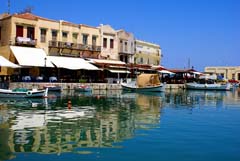- Rethymnon accommodation
- All Rethymno Accommodation
- Rethymnon Villas
- Stay in Agia Paraskevi Village
- Stay in Agia Triada Village
- Stay in Archea Eleftherna
- Stay in Gallou Village
- Stay in Giannoudi Village
- Stay in Kastri Village
- Stay in Melidoni village
- Stay in Monopari
- Stay in Mylopotamos
- Stay in Mysiria
- Stay in Plakias
- Stay in Prines Village
- Stay in Rethymnon Town
- Stay close to Rethymno Town
- Stay in Roustika Village
- Stay in Skaleta
- Stay in Tria Monastiria
- Accommodation in Greece
You need to upgrade your Flash Player
Please visit Adobe's Flash Player site to upgrade the most recent version.
Thank you.
If you are having issues with installing Adobe Flash Player, please make sure that all "pop-up killer" applications are turned off and you reinstall
the Adobe player.
Rethymnon information

Most important information about Rethymnon
general information
- Rethymnon is a prefecture in Crete island
- Area: 1,496 square km
- Population is approximately 82,234 inhabitants
- Capital of Rethymnon is Rethymnon Town
- Main port is in Rethymnon Town
- Connected with Piraeus port of Athens
- Connected via ferry with some Cycladic islands
- Connected with Athens Athens International Airport via Heraklio and Chania

Rethymnon distinguishes itself from the other prefectures by its very impressive and very diverse relief; striking mountains and low rolling hills, stunning gorges, cool, dim caves, productive valleys and plains. Even the gently rolling plateaus and splendid blue flag beaches compose the painting of a majestic landscape of postcard class. Here old-world mountain villages, which are the keepers of the bona fide Cretan way of life and cosmopolitan resorts, coexist harmoniously creating an enchanting contradiction in scenery that pleases the eye and offers variation.
This exquisite prefecture of Rethymnon is situated between the Prefecture of Chania (Hania) to the west and the Prefecture of Heralkion to the east where correspondingly the Lefka Ori (White Mountains) and mount Idi (also known to the locals as Psiloritis) form the natural boundaries of this prefecture. These peaks are what bestow the prefecture of Rethymno a series of characteristics that differentiate it from its equally impressive neighbouring prefectures. The once truly magical location of Preveli (now burned) and the sweeping plateau of Nida contrast sharply with the gorges of Kotsifou, Kourtalioti and Patsou are complemented by the valleys of Amariou and Doxarou. Three caves one should visit are namely Ideo Andro, Melidoniou, and Sfendoni. Twelve municipalities make up the prefecture of Rethymno and its capital, the city of Rethymno.
Historically, the Neolithic period provides the first evidence according to finds in the cave of Ideo Andreo however it was much later that meaningful development took place, roughly during the 4th and 3rd centuries B.C. when the city state of Rithimna minted its own coins, a sign of developing power. It was later still in 1573 that the formidable Venetian castle on the top of Paleokastro hill the Fortezza was built, a stronghold which did not prove to be much of an impediment later when the conquering Ottomans ran the Venetians out after a short siege in 1646. The landscape of Rethymno is studded - much like the rest of Greece - with historical sites, archaeological monuments, and grand old buildings. You will see ancient Byzantine, post renaissance Venetian and Turkish architecture that bear witness the long history of this area that dates back to the aforementioned Prehistoric Age and the highly developed Minoan Period which succeeded it. An important role throughout the Geometric, Classical, and Hellenistic Times continued to be played by the area.
Culture flourished during the period of the Venetian domination, the following Ottoman occupation ushered in a period of steep cultural decline witnessed by many other Ottoman occupied territories. Later in 1821 during the Greek War of independence, the inhabitants fought long and tenaciously as is their characteristic trait, overthrowing the Turks successfully.
Rethymnon or Rethymno has a population of about 28,000 inhabitants. The “old” is encompassed by the “new” stretching out along the waterfront in either direction. Outer or “new” Rethymno is a decidedly modern providing a wide variety of choices for comfortable accommodation. It is relatively well laid out with numerous parks and several open spaces. However in its old quarter it has commendably managed to keep its unique identity, this area is just a stroll from the picturesque Venetian port dominated by the old lighthouse. The old section of the city is characterized by constricted alleys that direct a pedestrian to delightful neighbourhoods of well preserved old buildings with old, weighty wooden doors and windows, some that date back hundreds of years, brilliant sunny squares, ornate marble Venetian fountains, antique Turkish public water taps and charming mansions with old world presence. The charming presence of elegant old style Byzantine churches, antique mosques and minarets arrest the visitors gaze and give one a good picture how things were many years ago.
The impressively imposing 16th century Venetian fortress named Fortezza which proudly stands on the hill of Paleokastro in the centre of the old town is a symbol of the city and offers an indescribably majestic view from its ramparts. The splendid, well organized sandy beach that stretches along the length of the harbour is another well known gathering place. It is lined with many café, bars and taverns a constitutes a firm favourite walkway among early morning bleary eyed patrons looking to drink a morning coffee in the warm sun, satiate their midday hunger pangs and have a good time into the early hours of the morning.

